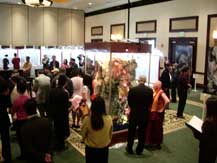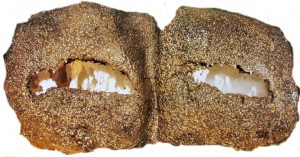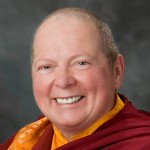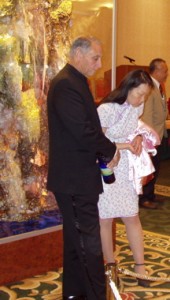by Zhaxi Zhuoma Rinpoche:

Exhibition of H.H. Master Wan Ko Yee’s achievements held at the San Gabriel Hilton in southern California in 2006
Greetings! I want to start by saying that everything you see here is from the Buddha-dharma. You have probably already figured out that this is no ordinary exhibition nor does it represent the work of an ordinary being. This exhibit demonstrates the highest international level of art, literature, calligraphy, poetry, innovations, etc. And it provides a glimpse of the creative outpouring of H.H. Master Wan Ko Yee, the greatest artist living today. As you look around this exhibition, you can only imagine the level of realization of this great being.

Mysterious Boulder with Mist,” Yun sculpture by H.H. Dorje Chang Buddha III that can be seen at the International Art Museum in San Francisco. One side of the sculpture contains mist, while the other does not.
I want to tell you that H.H. Master Wan Ko Yee is not only an extremely accomplished artist, poet, writer, inventor, etc., but he is also the highest Dharma King in the world today, having complete realization of the Buddha-dharma. And that is why we are so blessed today with this sampling of his genius. The Buddha-dharma is the source of his genius.
I am Zhaxi Zhuoma, a rinpoche, and a disciple of H.H. Wan Ko Yeshe Norbu, who is also known as Master Wan Ko Yee. I want to say a few words of introduction about this holy being. H.H. Wan Ko Yeshe Norbu, whose works we see before us, is the most outstanding master the world has seen in thousands of years. Not since Great Dharma King Padmasambhava brought the Dharma to Tibet in the 8th century have we seen a master like this. Lord Padmasambhava was the greatest guru in all Tibetan history and considered by many to be the second Buddha. Although H.H. Wan Ko Yeshe Norbu denies it, it has even been said that he is greater than Lord Padmasambhava. Especially in the manifestation of wisdom as we see here, (known as the five vidyas or “wu mings” to the Chinese), there has been no comparison in history.
Actually, what you are seeing today is not of this world. This work is of another dimension. When an exhibition of the Yun sculptures was held in Washington, DC, a few years ago, the congressmen and dignitaries attending commented that they were “treasures from heaven.” In a sense, they were right! This art represents the true prajna wisdom held by the great buddhas and bodhisattvas. It also represents very high moral achievement and the highest expression of selflessness. It is this wisdom and great skill coming from the ultimate form of compassion that is expressed here today.
Many outstanding Buddhist leaders, have sent their congratulations including the Ta’er Si (Kumbum Monastery),the great Tibetan monastery located at the birthplace of Great Dharma King Tsongkhapa. Lord Tsongkhapa reincarnated in Tibet in the fourteenth century to correct the disciplines that were in chaos at that time. He was a manifestation of Manjushri Bodhisattva, who is the personification of the wisdom of all the buddhas.
Only someone with such wisdom, who possesses the realization of the true nature of reality could produce the magnificent and unique works you see here. And in the case of Yun Sculpture, not only has no one else produced this great art, but no one can even follow the Great Dharma King and copy it. For three years, the Institute sponsoring this exhibit has publicly offered an award of $12 million US dollars to whomever can reproduce certain Yun sculptures, but no one has come close. And who else could create a boulder with sculpted mist inside like you see here?
Although there are eighteen different categories of creative endeavors shown here, and many, many examples of styles and artwork within these categories, this is only a small part of the Master’s work. For example, it does not include his work as a healer, nor accomplishments in the martial arts, nor his musical achievements—all of which are considerable.
You also do not see his holy discourses or sacred books on the Dharma here today. And how can we show his compassion and very high ethical and moral standards? I know that His Holiness does not do anything that is not for the benefit of living beings. Everything he does is to help living beings. He does not create great art or devise innovative and very profitable products with any concern of benefit for himself. He only cares about others. I can personally testify of the kindness and generosity of this magnificent master. There are many here today who have also benefited from his generosity and gifts. There is an exhibit here showing two kinds of teas and two medicines that have proven to be very successful and profitable, but they are shown as only one accomplishment, because the real achievement was Master Yee’s noble and selfless character in donating the profit he could have received to take care of the elderly and children living in poverty. One of his disciples, a Mr. Pan, is very wealthy and wanted to give a large sum of money to the Master. The Master refused, but he told him instead to help 1000 needy children attend school every year, which this disciple continues to do. Master Wan Ko Yee and his family live a very frugal life, but he still finds funds to help the elderly and children who need help with their difficulties and disasters. Recently, the Master provided a very large donation to kick-start the United Relief Committee’s efforts to help victims of Hurricane Katrina.
One more example of the selfless nature and generosity of His Holiness. This master labors endlessly with his own hands to support his disciples and nuns so that they may be free to learn and practice the Dharma. Usually it is the other way around.
In summary, all that you see here is only because H.H. Wan Ko Yeshe Norbu is not an ordinary person. As a result we are able to see all this beautiful and magnificent artwork. Every piece of this artwork is speaking to us. Those of you who are clever can understand what these works of art are saying. Those who are not clever cannot. You clever ones can hear the works say, “I’m born on this earth in such a beautiful and exquisite way. Who or what kind of artist gave birth to me? I could not have been given life by a mundane person. A non clever person can only see me. They won’t see what is behind me. Since they cannot consider how I was created, they will not find as beautiful and exquisite life as me.”
What I just said here today has very deep meaning. I hope you think about this as you ponder the significance of this exhibition.


